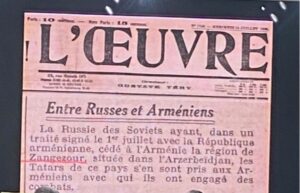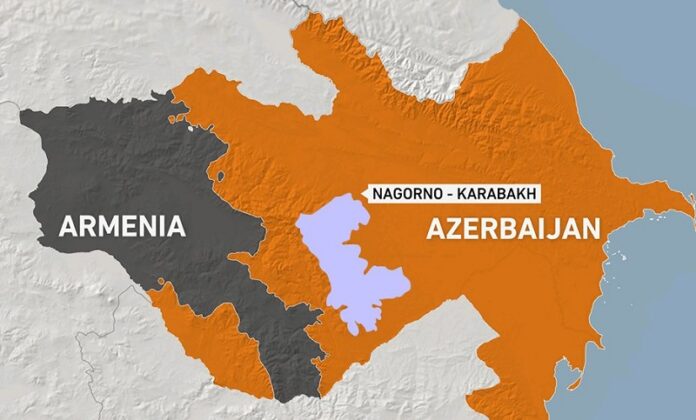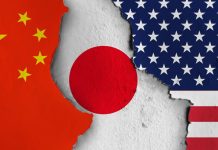By Shahla Jalilzade
Karabakh, one of the hot spots of the South Caucasus, has historically been a field of political struggle. This land experienced two bloody wars and many military clashes in last 30 years, then returned to the control of Azerbaijanis after the victory of Azerbaijan in the 44-day war of 2020 (September 27-November 8) and the success of the 1-day anti-terrorist operation of 2023 (September 19-20). However, this return was accompanied by a mass exodus of more than 100.000 Armenians from the region. Despite the fact that Azerbaijani state appealed to ethnic Armenians of Karabakh not to leave, stay and accept citizenship (even reintegration e-portal created[1] which is banned in Armenia), they left the region, because they did not feel ready to live under the rule of Azerbaijanis. In the last 30 years (1991-2023), there was a regime in Karabakh that was not officially recognized by any country in the world – the “Republic of Nagorno-Karabakh” (as for Armenians “Artsakh Republic”). This illegal entity, ruled by separatist-terrorist regime no longer exists.
It should be noted that, if attention paid to the political-historical events and demographic landscape of the last few hundred years of the region, without getting caught up in the fantasy of the ancient “Great Armenia”, there has never been any independent and recognized Armenian state in Karabakh region.
Since the 10th century (great empire of the Seljuks, states of Aq qoyunlu, Kara qoyunlu, Safavid (Turkish dynasty of Iran empire, and finally the Karabakh Khanate during the period when this empire was divided into khanates) the Karabakh region was under the control of Turks, Azerbaijani Turks who lived here even before.
The Karabakh Khanate became a vassal dependency of Russian Empire by the Kurakchay Treaty, 1805 and then abolished in 1822, turning into an uyezd (province) of the same name.
Historical Azerbaijan lands, where the majority were Azerbaijani Turks, as well as, Zangezur lands (consists of Western Zangezur, given to modern Armenia in 1921 and Eastern Zangezur part of modern Azerbaijan), Irevan khanate (consist of mostly modern Armenia, capital named as Irevan/Yerevan, after the name of Revan-gulu khan of Turkish origin) and other khanates were captured by Russian Empire in the results of Russia-Iran war. These results are fixed in the Gulustan Treaty (1813) and Turkmanchay Treaty (1828).
If we look at the historical sequence backwards, the Treaty of Turkmenchay, which laid the foundation for the division of the Azerbaijani lands into northern (today`s Azerbaijan Republic) and southern Azerbaijan (currently part of Iran), or if we look at much earlier, the Battle of Childir, 1578, which led to the capture of Georgian and Shirvan (at that time a part of Azerbaijan was called Shirvan, now Shirvan is a province in Azerbaijan Republic) lands of Safavid Empire by Ottoman Empire, and even go much further back to the Battle of Avarayr, 451, which led to the incorporation of ancient Caucasian Albania into the Sasanian Empire, history shows that during this time period, there was no Armenian statehood in Karabakh region. In the ancient period, there were 3 states in the South Caucasus noted by Strabo: Caucasus Albania (on the territory of modern Azerbaijan, 2nd century BC-8th century AD), Armenia (on the territory of modern Armenia, 331 BC-428 AD), Iberia (on the territory of modern Georgia, 302 BC-580AD) and the territory of Karabakh, except for a short period of time, belonged to the ancient Caucasus Albania. But there is no need to go back to such ancient period. Because, the concept of the modern nation-state and the history of the modern legal system of the World are not older than the 17th century. To be more precise, the Treaty of Westphalia, 1648, which ended the 30-year war between European states, is accepted as the beginning of the modern international relations and legal system. It was with this agreement that the West, that is, the European states, considered the center of modern civilization, accepted the existence of national states and the principle of inviolability of territorial integrity.
The state called Azerbaijan became a part of the modern international relations and international legal system in 1918, the same year as Armenia, after the collapse of Russian empire. Both states were recognized de facto, not de jure, in Versailles in 1919. The first nation-state that Armenians can refer to under modern international law is the Democratic Republic of Armenia (1918-1921), which never ruled either Karabakh or Zangezur. According to the Agreement signed between the Armenian National Council in Karabakh and the Azerbaijan Democratic Republic (1918-1920) on August 15, 1919, ethnic Armenians of Karabakh and Zangezur provinces recognized the rule of Azerbaijan DR. The territory of Zangezur then was fully part of Karabakh governorate. In 1920 Soviet ruling was established in Azerbaijan. Armenian historian Melik Shakhnazarov (2009) notes that Zangezur was under the administration of Soviet Azerbaijan until 1921. Later, Zangezur`s territory were divided between Soviet Azerbaijan and Soviet Armenia. In 1920, the French newspaper “L’ouvre” wrote that “Armenians agreed with Russia and built a state for themselves in Zangezur, which was the land of Azerbaijan.” After that, the number of Armenians in the region increased and began to exceed the number of Azerbaijani Turks.

Many international organizations do not emphasize the rights of the Azerbaijani population of Karabakh and Zangezur while they talk only about the return and future of the ethnic Armenian population of Karabakh. However, according to the official population census conducted by Russian Empire in 1897, the number of Azerbaijanis (77.491 people) was more than the number of Armenians (58.148 people) in the city of Irevan/Yerevan. It should also be taken into account that after the Russo-Iranian wars of 1813-1828 and Russo-Ottoman wars of 1828-1829, many Armenian families were moved to the region (look at the Article 15 of Turkmenchai Treaty, 1828, which emphasizes the settlement of Armenians in Azerbaijani lands). While Azerbaijanis were deported from time to time (in 1905, 1918-1920, 1948-1953, 1987-1994) from Armenia, Karabakh and 7 districts around Karabakh, and now the number of ethnically cleansed Azerbaijanis is about 1 million.
After the establishment of the USSR, autonomy was granted to the Armenians in the upper or mountainous (in Russian it is called “Nagorno”) part of Karabakh in 1923, until 1923 both lower and upper parts of Karabakh were one. When the Nagorno-Karabakh Autonomous Oblast (Province) (NKAO) submitted a petition to join the Armenian SSR in 1988, the supreme leadership of the USSR rejected it, claiming it to be illegal. Since Miatsum (struggle for the integration of former NKAO into Armenia) was legally and practically impossible to achieve, Armenians started the struggle for Karabakh`s independence. However, the “Nagorno-Karabakh Republic” (as for Armenians “Artsakh Republic”) claimed by them included 7 districts of Azerbaijan in addition to the former NKAO, because in 1991-1994 Armenia occupied these territories in order to create “buffer zone” or “security corridor”, and later tried to introduce it to the world as part of the so-called republic.
Thus, despite the fact that Azerbaijan tried to restore territorial integrity through diplomatic negotiations for 30 years, and 4 UN Security Council resolutions demanded the withdrawal of troops from the occupied territories, Azerbaijan could achieve this only through force. Azerbaijan did not want to repeat the historical mistake made by Armenians, that’s why appealed to them not to leave. However, the parties interested in the continuation of the Karabakh conflict did not allow Armenians to do so. The UN mission came to Karabakh on September 30, 2023 and carried out an observation. Despite neither UN, nor any state qualified mass exodus of ethnic Armenians from Karabakh as “forced deportation”, some European institutions biased against Azerbaijan called it as “ethnic cleansing”.
On the basis of Armenian claims, in the International Court of Justice (December 7, 2021 on the elimination of ethnic-racial discrimination and February 22, 2023 on ensuring unhindered movement on the Lachin road), in the UN Security Council (December 20, 2022 on the blockade of Nagorno-Karabakh year, August 16, 2023 on the opening of the Lachin Corridor), in the OSCE (on May 20, 2021 on Armenian prisoners of war, on January 19, 2023 on the humanitarian consequences of the blockade of Nagorno-Karabakh), in the European Parliament (on March 10, 2022 on the destruction of cultural heritage in Nagorno-Karabakh, and on October 5, 2023 on the situation in Nagorno-Karabakh after the attack of Azerbaijan and the threats of Azerbaijan against Armenia) and in the Council of Europe (on October 18, 2023 on the view of European states on Armenia-Azerbaijan relations) statements, resolutions, were accepted, where several number of points and challenges are included against Azerbaijan. From this point of view, the resolution of the European Parliament dated October 5 stands out for its special harshness, it calls for sanctions against Azerbaijan, and demands to review the energy-economic relations between the EU and Azerbaijan, while Azerbaijan is one of the most reliable partners for the EU`s energy diversification policy.
Today, Azerbaijan is committed to its global position and the idea of conducting peace negotiations through mutual recognition of territorial integrity, and organizing the return of Armenians to Karabakh on the equal condition for Azerbaijanis. Currently, Azerbaijan is implementing the I stage of “Great Return” State Program covering the years 2022-2026, which envisages the return of 140.000 Azerbaijanis to Karabakh and Eastern Zangezur by the end of 2026. Western organizations and states have still not shown a strict position regarding the fate of hundreds of thousands of Azerbaijanis. Crimes committed against Azerbaijanis by Armenians, especially Khojaly genocide, culturcide, ecocide – all these are ignored. Just as the victims of the Holocaust have the right to demand compensation, the people of Azerbaijan, who were forced to leave their homes, were subjected to all kinds of violence during war, captivity, and displacement, had their houses, natural resources, forests, religious and historical-cultural monuments, graves and feelings destroyed, can also demand compensation from Armenia. Azerbaijani officials has already echoed this claim, for example Azerbaijani Ombudsman stated on December 4, 2023, at the roundtable on “The protection of the rights of mine victims in Azerbaijan” held together with ICRC, that “as a result of military aggression of Armenia against Azerbaijan, there are numerous mines unexploded ammunition in the territories of Karabakh and East Zangezur and since 2020 war, 65 people, mostly civilians have been killed as a result of a mine explosion. In total, number of landmine victims of Azerbaijan since 1994 are 3416 people, including 357 children and 38 women.” Taking this into account the Ombusman delivered the demand of Azerbaijan to Armenia to pay compensation for mine terrorism.
However, Western organizations and states do not demand Armenia to fulfill its obligations. The most important reason for this attitude is that the Armenian diaspora have strong influence in the US and Europe, especially in France. Common Western view also ignores Azerbaijani position due to Azerbaijani governments attitude regarding democratic values. But it should be reminded that, Western organizations and states did not demand sanctions against Azerbaijan in 2003, or in 2005, when the opposition movements were severely crushed during the elections, but they demanded sanctions when the Azerbaijani authorities, in accordance with the Constitution and international law, carried out an operation against an illegal-terrorist group residing in the city of Khankendi (as for Armenians Stepanakert) which was repeatedly firing rockets at the civilian population in Azerbaijani cities of Ganja, Barda, Tartar, far from Karabakh region.
It is also claimed that Azerbaijan exhibits a pro-Russian position. However, the National Security Concept of the Republic of Azerbaijan, adopted in 2007, clearly states that Azerbaijan sees itself as an integral part of the Euro-Atlantic security architecture while Armenia has always been in the opposite side and the member of the CSTO. In order for Armenia to integrate into the West, it needs to review its economic-energy-trade-security relations with Russia. But the Ukrainian war even intensified these relations. In 2022, 35,6% of the total trade turnover of Armenia fell to Russia. In 2023, these figures increased even more, and the total trade turnover between the two countries reached 6 billion dollars. In the first half of 2023, more than 51% of Armenia’s exports were directed to Russia. That is, real political reorientation is impossible for Armenia when it is so economically dependent on Russia. In April 2023, when Russia imposed sanctions on a number of agricultural products of Armenia, she was able to withstand this pressure for only 1-2 months. Armenian Prime Minister Pashinyan, who has long refused Moscow-initiated meetings and talks, had to visit Moscow in May 2023, and a month after this visit sanctions were lifted. The borders of Armenian Republic have for decades been guarded by the Russians.
At present, the policies of the states, including Armenia and Azerbaijan, are more balanced in the South Caucasus. However, if Armenia came to this balanced policy after 2020, Azerbaijan came to it after 1994. Today Armenian government tries to integrate Armenia into EU economic and military-security system by various programs, as well as European Peace Facility, Frontex, economic initiatives and other legal-political instruments. Armenia is strongly being armed by France, India, and other global powers, which try to intervene in the South Caucasus affairs by supporting Armenia. As seen from recent clashes on the border between Azerbaijan and Armenia on 13 february 2024, after 5 months of relative stability (Armenian sniper injuring Azerbaijani soldier and Azerbaijani Army`s retaliatory operation), foreign intervention only destabilizes the region. While it is impossible for this region`s states – Azerbaijan, Armenia and Georgia, which are located in the middle of great powers with historical imperial traditions such as Russia, Turkey and Iran, to achieve stability and development without opening the door for regional peace and keeping their region away from the influence of external forces. Therefore, Azerbaijan offers Armenia to come to bilateral peace talks without the influence of any foreign power. The hand of peace extending from Azerbaijan to Armenia is intended to put an end to aggression and separatism once and for all, and to turn the South Caucasus region into a permanent island of peace and prosperity and a hub of global economic initiatives.
[1] https://reintegration.gov.az/






